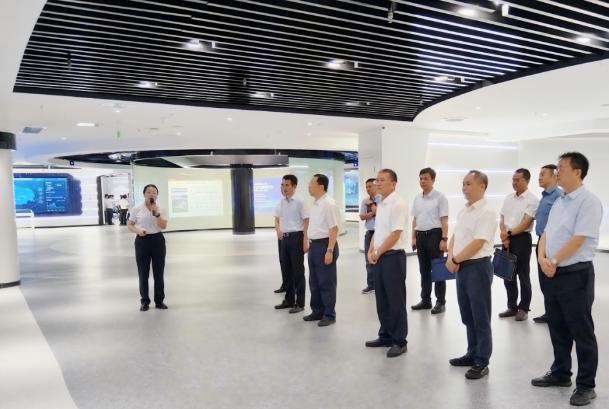图片 Image © MVRDV
MVRDV联合浙江大学建筑设计研究院有限公司中标武汉图书馆新馆建筑概念方案设计竞赛。这座总建筑面积约为140,000平方米的图书馆将成为中国最大的图书馆之一,MVRDV的方案融合了传统和非传统的功能,提供了多样化的学习、人文互动、阅读和工作室空间。三个大型观景窗将建筑与周围环境在视觉上连接起来,透过窗口,图书馆内部的动态一览无余,从而激发人们的好奇心和探索欲。独特的三面流线型设计,彰显百湖之城在两江交汇处的独特地位,将成为武汉市令人瞩目的新地标。
MVRDV, in collaboration with UAD, has won the competition to design a new central library for Wuhan, China. Poised to become one of the largest libraries in China, the approximately 140,400-square-metre project combines traditional and non-traditional functions with diverse study, living room, reading, and studio spaces. The building connects to its surroundings via three large openings that will act as visual displays of life inside the building, sparking curiosity and intrigue. This distinctive, three-faced flowing shape celebrates the position of the “city of 100 lakes” at the confluence of two rivers, and will become a new recognisable landmark for Wuhan.
图片 Image © MVRDV
图片 Image © MVRDV
武汉图书馆新馆项目位于武汉王家墩中央商务区核心地段,常青路与云彩路交汇处,紧邻宝丰路高架,位置醒目,未来将集图书馆文献、信息服务、科技创新和研究资源于一体。建成后的新馆将进一步完善武汉市公共信息服务体系建设,满足阅读、学习、交流、创新等功能需求,助力武汉的社会经济发展。
Located at a highly visible site next to the Baofeng overpass in Wuhan’s Central Business District, the Wuhan Library will integrate literature, information services, as well as scientific and technological innovation and research resources. The new library will improve Wuhan’s public information service system, and meet functional needs in terms of reading, learning, communication, and innovation, while enhancing the city’s urban economy.
图片 Image © MVRDV
MVRDV的设计概念从武汉的地理环境中汲取灵感,从建筑、室内、空间质量和材料,都彰显了河流无形之水的雕塑力。三个巨大的观景窗在形式上参考了周边建筑的高度,分别朝向城市三个角度的最佳景观。每一面观景窗都与一处独立的景观相呼应:最高的观景窗远眺中央商务区的天际线、较低而宽阔的观景窗将对面公园的美景尽收眼底;长而弯曲的观景窗将毗邻的广场纳入视野,让来往经过的人透过它一睹馆内的生机景象。
The building concept takes its cues from the geography of Wuhan, celebrating the sculptural force of the rivers not only in its form but also in its interior character, spatial qualities, and materials. It references the different heights of the surrounding buildings in its form, with three dramatic picture windows facing the city at different vantage points. Each opening addresses a discrete view: the tallest of the three windows faces the CBD’s skyline; a low, wide window offers panoramic views of the park opposite; and a long, curving window embraces the adjacent plaza, offering passers-by a glimpse of the vibrancy inside.
图片 Image © MVRDV
图片 Image © MVRDV
图书馆内部的空间概念进一步强化了武汉位于两江交汇处、坐拥城市景观的重要地位。室内有着峡谷般的阶梯式书架露台,以及底层宽阔的公共空间,面向游客全天开放。梯台上类似展馆的空间容纳了图书馆所设置的不同功能,“峡谷”的设计将空间分隔为不同的区域和体验,例如安静的阅读区、共享工作区,书架本身也成为“峡谷地貌”的一部分。其中的“阅读之谷”是馆内的核心空间之一,是其中容纳的所有知识与内容的交汇点。
The interior concept further reinforces the notion of Wuhan’s position at the confluence of rivers, surrounded by the city landscape. The stepped terraces of books invoke the sculptural lines of a canyon, with a broad ground-floor public space that visitors can enjoy throughout the day. Pavilion-like spaces on the terraces contain the library’s different programme and the canyon gives shape to different zones and interior experiences, with quiet reading areas, group work areas, and bookshelves as part of its topography. The reading canyon is a pivotal space, and represents a confluence of knowledge coming together inside the building.
图片 Image © MVRDV
“步入武汉图书馆新馆,会看到不同的景观元素汇聚在一起。”MVRDV创始合伙人 Jacob van Rijs 说道,“馆内有一系列连绵的‘平台’作为学习的场所,最大的平台将是最受欢迎的地方。越往高处走,学习和阅读的空间就会越安静,满足读书者的需求。建筑设计的灵感受到武汉地形的启发:建筑的水平视角面向湖泊,垂直视角则面向高楼林立的城市,反映了自然与城市的对话,也是建筑设计关注的重点。正因为如此,这座图书馆将会是令人振奋的聚集场所。”
“Going inside, certain landscape elements come together,” says Jacob van Rijs, founding partner of MVRDV. “There is a series of plateaus that can be used for studying. The biggest one will be for the more popular areas. The higher up you go, the quieter the study and reading spaces will be, serving the needs of visitors. The topography of Wuhan was an important source of inspiration: we have this idea of a horizontal view towards the lakes and on the other hand, we have this more vertical view towards the city with the high rises. This is nature versus the city, and the building is somehow focusing on this. I think this makes it an exciting place to gather.”
图片 Image © MVRDV
从城市的角度,建筑物内部宏伟的“峡谷”将吸引游客驻足。周边公园种植的绿植与武汉当地的气候条件相得益彰,是可长期持续维护的景观元素。高大的树木为阳光强烈的区域提供荫庇,主要的公共区域也位于建筑物西北角的阴凉处。原生植被几乎不需要维护也能保持全年活力,还可以在雨季滤水,在炎夏减少热岛效应。
At an urban level, the grand interior canyon draws visitors inside. In the surrounding park, planting will complement Wuhan’s climate conditions to ensure long-term sustainable maintenance. Tall trees provide cooling in areas that experience intense sunlight, while the main public areas are shaded by the northwest corner of the building. Native vegetation requires little maintenance and maintains a year-round vibrancy, while filtering the water in the rainy season and reducing the heat island effect during hot summer months.
图片 Image © MVRDV
MVRDV在设计中考虑到武汉的炎热气候,采用了多项措施降低建筑能耗。建筑外立面安装了类似书架状的百叶窗板,在为室内遮阳的同时,体现了图书馆的功能。阳光照射强烈的部分设置了更密集的百叶窗板;此外,建筑的基座为悬挑结构,因而也发挥了遮阳的作用。可开启的门窗保持室内自然通风,并与智能设备和高效的照明系统相结合,进一步降低建筑的能源需求,而与流动屋顶形状为一体的太阳能电池板还可以为建筑提供可再生能源。
Several measurements are taken to reduce energy consumption in Wuhan’s hot climate. The building’s façade incorporates louvres in a bookshelf-like pattern, communicating the building’s function as they shade the interior. These louvres are more densely packed in the places that need the most shade from the sun; meanwhile, the building’s plinth is set back to create large cantilevers that offer shade. Openable elements for natural ventilation, combined with the use of smart devices and an efficient lighting system further reduce the building’s energy demands, while solar panels incorporated into the library’s flowing roof shapes provide the building with renewable energy.
图片 Image © MVRDV
武汉图书馆新馆并不是 MVRDV在中国设计的第一座图书馆。MVRDV于2017年设计了天津滨海图书馆,作为该城市文化区总体规划中的一部分。这座占地 33,700 平方米的文化中心设有发光的球形礼堂和落地式层叠书架。就如武汉图书馆一般,天津滨海图书馆的功能也不仅仅是一个教育中心,它同时也是一个社交空间,把公园与城市文化区连接在一起。
This is not the first library MVRDV has designed for China: in 2017, MVRDV presented the Tianjin Binhai Library as part of a larger masterplan to provide a cultural district for the city. The 33,700m2 cultural centre features a luminous spherical auditorium and floor-to-ceiling cascading bookcases. Just like the Wuhan Library, this library functions as more than an educational centre: it serves as a social space and connector from the park into the city’s cultural district.





发表评论 取消回复